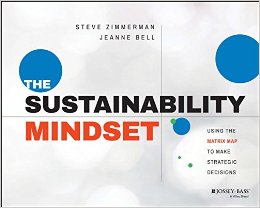
I pre-ordered this book as soon as I heard about it. I was expecting a sequel to Zimmerman and Bell’s earlier book, Nonprofit Sustainability. But The Sustainability Mindset is actually a successor to that important, earlier work.
My first impression is awe at the authors’ ability to pack so many rich ideas and useful tools into just 200 pages. Beyond the sage advice, I counted no less than 43 figures, 7 tables, 4 sample exhibits, 3 case studies and 23 templates.
The book walks you through a six-step sustainability planning process. As in their earlier work, the central tool of this book is the “matrix map,” a 2-axis, 4-quadrant table that plots the dual bottom-line of a nonprofit: mission impact and financial viability. The idea is that the leadership team assesses the organization’s programs and determines each program’s “profitability” and mission impact. The results are plotted on the matrix map, using circles that are scaled according to each program’s expenses. The composite map provides a comprehensive picture of the organization’s business model. See the example below.

The four quadrants are named to help with downstream analysis and management:
Low Profitability-Low Mission Impact programs are called “Stop Signs.” These are programs that the organization should discontinue or give away to another organization.
Low Profitability-High Mission Impact programs are called “Hearts.” These are programs that are the heart of the organization’s mission, but usually require subsidy. The management challenge is to determine if the program can be conducted more economically – increasing its profitability – or if the program’s future prognosis warrants a subsidy from other programs.
High Profitability-High Mission Impact programs are appropriately called “Stars.” Obviously, these are programs to continue to invest in and grow.
High Profitability-Low Mission Impact programs are called “Money Trees.” These are programs to also nurture and grow, and where possible, try to elevate their mission impact.
I’ve used the matrix map in business planning with nonprofit clients and can attest to its power. It’s amazing to watch the board and executive team get, quite literally, on the same page about the organization’s business model and how to manage and nurture its programs going forward.
However, getting there requires some work. Fortunately, Zimmerman and Bell have provided a clear process with detailed advice for every step along the way, including composition of the planning team, agendas for meetings, and worksheets to facilitate the process.
One of the knottiest issues in the process is agreeing on the criteria for the mission impact assessment. They suggest first coming up with an agreed upon impact statement: “…a specific statement about what the organization will accomplish and for what it will be held accountable. It focuses the organization and defines whom it serves and the desired outcome.” An impact statement is not the same as a mission statement. In my words, an impact statement should define how the world will be different and for whom as a result of the organization’s work. Zimmerman and Bell make an important point that programs can be aligned with mission but still be highly variable in their impact and outcomes.
With impact statement in hand, they suggest conducting the assessment by defining four criteria from seven types that they propose, including two that they believe are mandatory: (1) contribution to intended impact (mandatory) – the extent to which the program achieves the outcomes or aims defined in the impact statement; (2) excellence in execution (mandatory) – the organization’s ability to deliver the program results on a day-by-day basis; (3) scale – the reach of the program; (4) depth – depth of the program’s impact; (5) significant unmet need – the extent to which the program is the only option in the community; (6) community building – the extent to which the program contributes to meaningful connection with the community, inclusion or convening; and (7) leverage – the ability of the program to leverage partnerships or other resources.
With the matrix map built, thoroughly digested by the board and executive team (potentially the staff, too), the work of strategically managing the programs to contribute more effectively to the dual bottom-line can begin.
The book includes a chapter of case studies and a concluding chapter that ties everything together and provides a strategy framework, offering the process as a substitute for strategic planning.
As a former executive director, long time consultant, planning guide, and champion of nonprofits, I think the ideas and processes that Zimmerman and Bell offer can be utterly transformative for individual nonprofits. If you are a nonprofit CEO, get this book, devour it, and have your board and executive team read it. Then use it and see your community reap the rewards, today and into the future. You might even find your work a little easier when your board and executive team have a more complete picture of the business fundamentals of the organization, and align on how to advance mission impact.
If you’re not ready to read the book, here’s a link to an article in The Nonprofit Quarterly that provides more details about the process: The Matrix Map: A Powerful Tool for Mission-Focused Nonprofits.
Click here to buy The Sustainability Mindset from Amazon.com.
